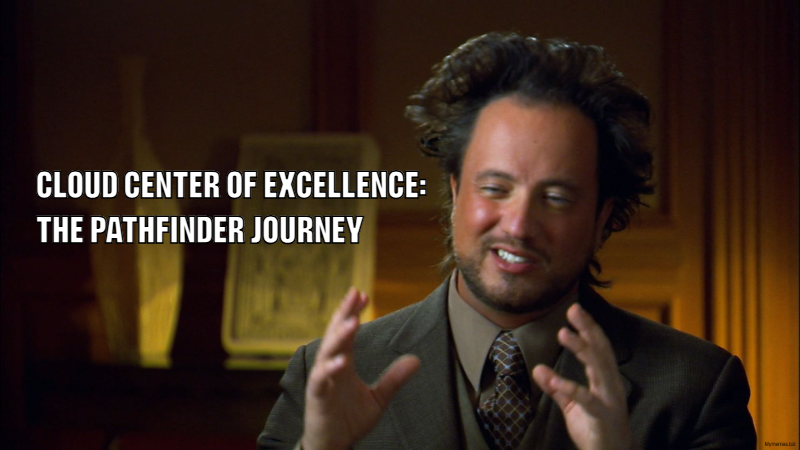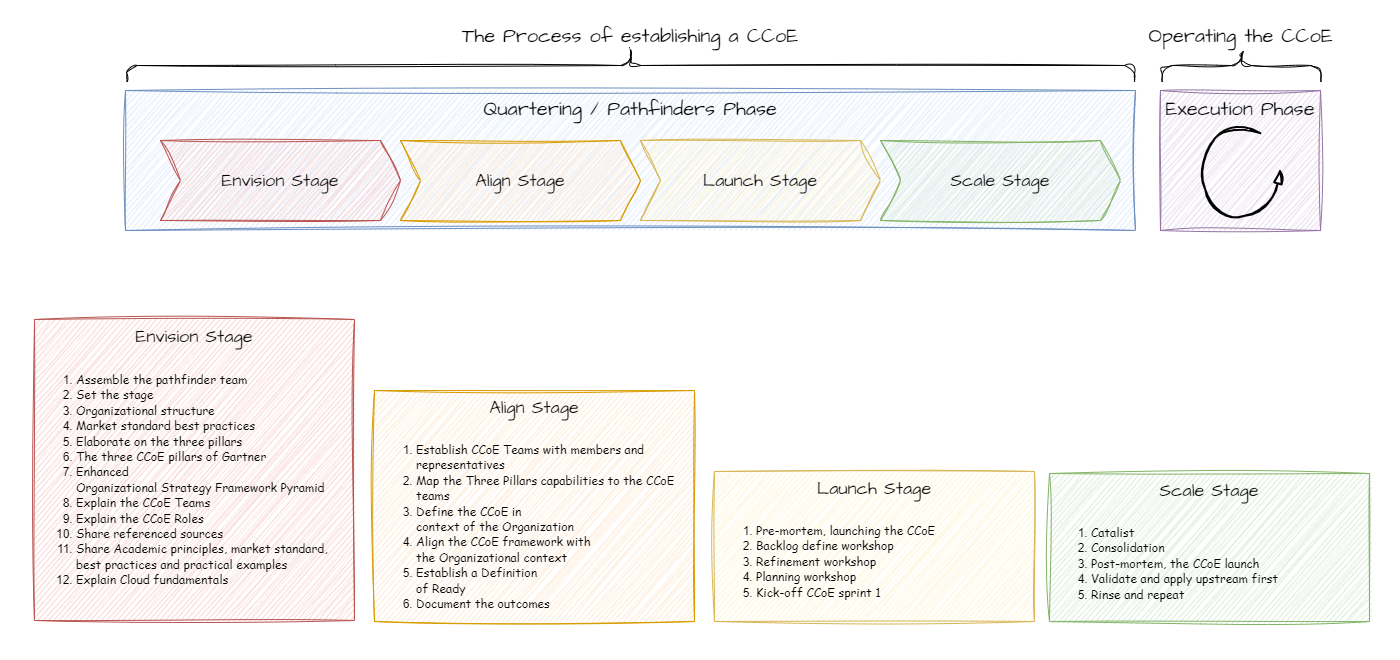🌐💼 Building a Cloud Center of Excellence: The Pathfinder Journey 🌟🚀

Introduction
The concept of a Cloud Center of Excellence (CCoE) is well-documented, and many organizations recognize its added value in driving innovation and operational efficiency. However, while there is a wealth of information on what a CCoE is, practical guidance on how to effectively implement one is often lacking, leaving organizations with more questions than answers. Even comprehensive resources like Microsoft’s Cloud Adoption Framework primarily focus on the functions of a CCoE in its end-state without delving into the intricacies of its establishment.
This blog series aims to fill that gap by providing a detailed roadmap for creating a successful Cloud Center of Excellence (CCoE). Drawing from (mine & Mike Beerman’s ) personal experiences and insights, this series will guide organizations through the various phases of establishing a CCoE, offering actionable steps and best practices to navigate this complex journey.
The Pathfinder Phase, also known as Quartering, is where this journey begins. It serves as an exploratory phase that shapes the foundation of a successful CCoE and culminates in scaling the CCoE to drive broader organizational impact. We envision this phase to consist of four key stages: Envision, Align, Launch, and Scale. Each stage of the Pathfinder Phase serves a distinct purpose, and this post will provide an overview of these stages, setting the stage for more detailed breakdowns in subsequent posts. Whether you’re just starting your CCoE journey or looking to optimize an existing framework, this series will provide valuable insights to help you succeed.

The Concept of Quartering (Pathfinding)
The role of a pathfinder in establishing a CCoE can be likened to the concept of a Quartermaster, a unique profession loosely comparable to the civilian role of a “Chief of Staff”. Historically (dating back to the 15th century in Europe), a “Quartermaster” (Kwartiermaker in Dutch, or Kwartier-meester in early 15th century Dutch naval terms) in the military was responsible for preparing new military encampments, including strategic placement and provisioning of logistical supplies. This ensured that everything was in place for the troops to settle in efficiently and safe from hostile forces.
In the context of a CCoE, pathfinders act as pioneers or trailblazers who lay the groundwork for something new within or between organizations. They work closely with stakeholders to shape this new initiative until it can be transitioned into a new organizational unit. This process involves continuous adaptation and preparation, much like the role of a Quartermaster. This ensures that the foundation is solid before scaling the initiative for production purposes.
Envision Stage
Establish the foundational vision and framework for the CCoE.
- Assemble the Pathfinder Team: Identify key stakeholders and early adopters to form a team that will champion the CCoE.
- Set the Stage: Define the mission, expected outcomes, and long-term goals of the Pathfinder stage.
- Organizational Structure: Establish reporting lines, team roles, and collaboration models for the Pathfinder stage.
- Industry-Standard CCoE Mission Statement: Present the industry-standard CCoE mission statement to the team, ensuring they understand and acknowledge its purpose.
- Three Pillars of a CCoE by Gartner: Align on Governance, Brokerage, and Community capabilities and determine their practical implications.
- Enhanced Operational Management Pyramid: Align CCoE objectives with business strategies at all levels.
- Establish the CCoE Teams: Detail the core teams within the CCoE and their primary functions aligned with Team Topologies.
- Explain the CCoE Roles: Define responsibilities for key roles, including Cloud Architects, Engineers, and Governance Leads.
- Establish Foundational References and Best Practices: Define key academic and industry sources that underpin the CCoE vision, alongside guiding principles, market standards, and real-world case studies.
- Explain Cloud Fundamentals: Ensure that all stakeholders understand the essential concepts of Cloud computing and Agile methodologies.
Align Stage
Turn the vision into an actionable strategy.
- Establish CCoE Teams with Members and Representatives: Form dedicated teams with clear roles, assigned to named individuals for ownership.
- Map the Three Pillars Capabilities to the CCoE Teams: Align governance, automation, and enablement capabilities to specific teams.
- Define the CCoE in Context of the Organization: Ensure alignment with business objectives and existing organizational structures.
- Align the CCoE Framework with the Organizational Context: Customize the framework to fit the organization’s unique needs.
- Establish a Definition of Ready: Define clear criteria for when the CCoE is prepared to move forward with initiatives.
- Document the Outcomes: Maintain clear records of decisions, strategies, and goals to track progress.
Launch Stage
Implement the initial structure and processes of the CCoE.
- Pre-mortem: Conduct a pre-mortem analysis to identify potential risks and challenges before launching the CCoE. This proactive approach helps mitigate issues that could derail the initiative, by managing them as impediments.
- Launching the CCoE: Officially kick off the CCoE by communicating the vision, goals, and expected outcomes to all stakeholders. Ensure everyone understands their roles and responsibilities.
- Backlog Define Workshop: Organize a workshop to define the initial backlog of work items per team. This involves prioritizing initiatives based on their impact and feasibility.
- Refinement Workshop: Conduct a refinement workshop to break down the backlog items into actionable tasks. Ensure that each task is well-defined and aligned with the CCoE’s objectives.
- Planning Workshop: Develop a detailed plan for executing the backlog items. This includes defining sprints, assigning ownership, and allocating resources.
- Kick-off CCoE Sprint 1: Begin the first sprint of the CCoE, focusing on delivering incremental wins (often) and building momentum. Continually monitor progress closely and make adjustments as needed in retrospection.
Scale Stage
Expand, optimize, and drive continuous improvement.
- Catalyst: Identify and implement catalysts that drive adoption and engagement. These could include training programs, incentives, or communication campaigns.
- Consolidation: Consolidate learnings and best practices from the initial sprints. Document these insights to inform future initiatives and improve overall efficiency.
- Post-mortem: Conduct a formal post-mortem analysis to evaluate the success of the CCoE launch. Identify what worked well and what could be improved. Use this feedback to refine the CCoE’s strategies and processes.
- Validate and Apply Upstream First: Validate the CCoE’s framework and apply an ‘upstream first principle’ to ensure alignment with broader organizational goals. This step helps integrate the CCoE’s efforts with existing processes and workflows.
- Rinse and Repeat: Continuously iterate and improve the CCoE’s operations. Use feedback loops and KPIs to measure progress and make data-driven decisions. Repeat this cycle until the CCoE reaches a stable and optimized state. The above overview of the Pathfinder Phase sets the stage for the detailed breakdowns of each stage. We will select detailed topics in subsequent posts.
📌 Key Takeaways
- The Pathfinder Phase (Quartering) is a crucial part of the CCoE journey—it represents the pioneering phase that helps shape the foundation of a successful CCoE, consisting of Envision, Align, Launch, and Scale stages.
- Each stage plays a key role in shaping, defining, implementing, and scaling the CCoE.
- Future posts will explore each stage in more depth, detailing the steps and best practices involved.
Wrapping up
Stay tuned for the next post, where we’ll dive deeper into the specifics of the Envision Stage and how to set a strong foundation for your CCoE! 🚀 If you found this post useful, be sure to explore the reference materials that inspired this solution:
- Microsoft Cloud Adoption Framework
- Set Up Your Organization for Cloud Adoption Success - Gartner
- Execute Your Cloud Strategy With a Cloud Center of Excellence - Gartner
- Building a CCOE to transform the entire enterprise
- The CCoE phases
- How to Build a Successful CCoE: A Step-by-Step Guide
- How to build a cloud center of excellence
- Kwartiermakersgilde
- Quartermaster - Britannica
- Quartermaster - Wikipedia
Thank you so much for taking the time to read this post. If you enjoyed it or learned something new, don’t hesitate to check out my other posts . If you have questions or feedback, feel free to reach out via LinkedIn . Until next time, happy automating! ✨